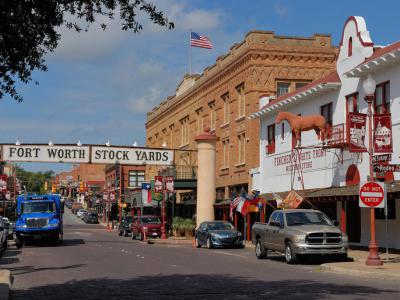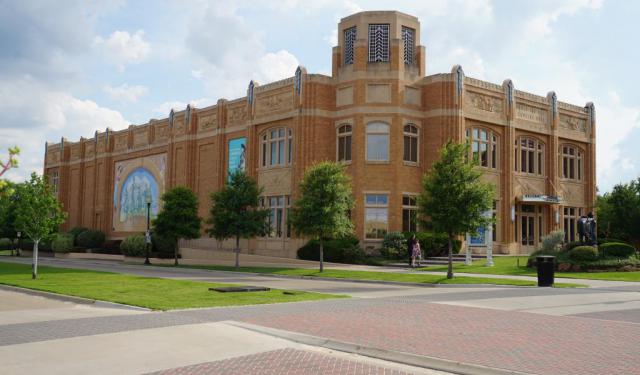
Fort Worth Stockyards National Historic District, Fort Worth (must see)
The Fort Worth Stockyards is a historic district that is located in Fort Worth, Texas, north of the central business district. A 98-acre (40 ha) portion encompassing much of the district was listed on the National Register of Historic Places as Fort Worth Stockyards Historic District in 1976. It holds a former livestock market which operated under various owners from 1866.
The Fort Worth Stockyards now celebrates Fort Worth's long tradition as a part of the cattle industry and was listed on the National Register as a historical district in 1976. The listing included 46 contributing buildings and one other contributing structure. Recorded Texas Historic Landmarks within the district include the entrance sign, the Livestock Exchange Building, and the Thannisch Block Building housing the Stockyards Hotel. State Antiquities Landmarks also include the entrance sign as well as the Armour & Swift Plaza and the Cowtown Coliseum.
The Stockyards consist of mainly entertainment and shopping venues that capitalize on the "Cowtown" image of Fort Worth. Home to the famous boot making company M.L. Leddy's which is located in the heart of the Stockyards and The Maverick Fine Western Wear and Saloon where customers "can 'belly up' to the bar, relax and have a cold beer while in the Stockyards; just like they did in the days of the big cattle drives", as they shop around the store. The city of Fort Worth is often referred to as "Where the West Begins." Many bars and nightclubs (including Billy Bob's Texas) are located in the vicinity, and the area has a Western motif. There is also an opry and the weekly Stockyards Championship Rodeo. The Library of Congress states in their notes ~ "They are the last standing stockyards in the United States." Some volunteers still run the cattle drives through the stockyards, a practice developed in the late 19th century by the frontiersman Charles "Buffalo" Jones, who herded buffalo calves through the streets of Garden City, Kansas.
On April 1, 2011, the Fort Worth Stockyards Stables were remodeled and reopened. They are located next door to the Hyatt hotel in an original Historic Stockyards building that was built in 1912. Moved to the Armour building after the 2015 remodel. The stables offers horse rentals on the open trails of the Trinity River and carriage rides.
The Grapevine Vintage Railroad runs a heritage railway service between Grapevine station and The Stockyards.
The Fort Worth Stockyards now celebrates Fort Worth's long tradition as a part of the cattle industry and was listed on the National Register as a historical district in 1976. The listing included 46 contributing buildings and one other contributing structure. Recorded Texas Historic Landmarks within the district include the entrance sign, the Livestock Exchange Building, and the Thannisch Block Building housing the Stockyards Hotel. State Antiquities Landmarks also include the entrance sign as well as the Armour & Swift Plaza and the Cowtown Coliseum.
The Stockyards consist of mainly entertainment and shopping venues that capitalize on the "Cowtown" image of Fort Worth. Home to the famous boot making company M.L. Leddy's which is located in the heart of the Stockyards and The Maverick Fine Western Wear and Saloon where customers "can 'belly up' to the bar, relax and have a cold beer while in the Stockyards; just like they did in the days of the big cattle drives", as they shop around the store. The city of Fort Worth is often referred to as "Where the West Begins." Many bars and nightclubs (including Billy Bob's Texas) are located in the vicinity, and the area has a Western motif. There is also an opry and the weekly Stockyards Championship Rodeo. The Library of Congress states in their notes ~ "They are the last standing stockyards in the United States." Some volunteers still run the cattle drives through the stockyards, a practice developed in the late 19th century by the frontiersman Charles "Buffalo" Jones, who herded buffalo calves through the streets of Garden City, Kansas.
On April 1, 2011, the Fort Worth Stockyards Stables were remodeled and reopened. They are located next door to the Hyatt hotel in an original Historic Stockyards building that was built in 1912. Moved to the Armour building after the 2015 remodel. The stables offers horse rentals on the open trails of the Trinity River and carriage rides.
The Grapevine Vintage Railroad runs a heritage railway service between Grapevine station and The Stockyards.
Sight description based on Wikipedia.
Want to visit this sight? Check out these Self-Guided Walking Tours in Fort Worth. Alternatively, you can download the mobile app "GPSmyCity: Walks in 1K+ Cities" from Apple App Store or Google Play Store. The app turns your mobile device to a personal tour guide and it works offline, so no data plan is needed when traveling abroad.
Fort Worth Stockyards National Historic District on Map






Sight Name: Fort Worth Stockyards National Historic District
Sight Location: Fort Worth, USA (See walking tours in Fort Worth)
Sight Type: Attraction/Landmark
Sight Location: Fort Worth, USA (See walking tours in Fort Worth)
Sight Type: Attraction/Landmark
Walking Tours in Fort Worth, Texas
Create Your Own Walk in Fort Worth
Creating your own self-guided walk in Fort Worth is easy and fun. Choose the city attractions that you want to see and a walk route map will be created just for you. You can even set your hotel as the start point of the walk.
Fort Worth Historical Buildings
Among the many ways to explore the richness of heritage fabric in Fort Worth there is one by historical architecture. Back in the 1920s-30s, the majority of Fort Worth’s notable buildings were designed by either Sanguinet & Staats or Wyatt Hedrick.
The former, in particular, were responsible for creating, among other structures, the Flatiron – one of the first high-risers in Fort Worth.... view more
Tour Duration: 2 Hour(s)
Travel Distance: 3.5 Km or 2.2 Miles
The former, in particular, were responsible for creating, among other structures, the Flatiron – one of the first high-risers in Fort Worth.... view more
Tour Duration: 2 Hour(s)
Travel Distance: 3.5 Km or 2.2 Miles
Stockyards Cowtown Walking Tour
Once a major livestock center and a home to cowboys, cattlemen and outlaws, Fort Worth, TX has fully lived up to its nickname – “Cowtown.” From the late 1870s through the mid 1980s, the Fort Worth Stockyards made the city famous, drawing cattle from all over the state. Today mainly inactive, the Stockyards – "the last standing stockyards in the United States" – celebrates Fort... view more
Tour Duration: 1 Hour(s)
Travel Distance: 0.8 Km or 0.5 Miles
Tour Duration: 1 Hour(s)
Travel Distance: 0.8 Km or 0.5 Miles
Cultural District Walking Tour
Just minutes away from the hustle and bustle of the downtown's daily commerce, the Fort Worth Cultural District is a true gem deep in the heart of the city. Bordered by a tree lined boulevard paved with bricks and surrounded by manicured grounds, the area is alive with charming shops and restaurants.
But most importantly, the district is a home to the five prominent museums, such as the... view more
Tour Duration: 2 Hour(s)
Travel Distance: 3.5 Km or 2.2 Miles
But most importantly, the district is a home to the five prominent museums, such as the... view more
Tour Duration: 2 Hour(s)
Travel Distance: 3.5 Km or 2.2 Miles
Fort Worth Introduction Walk
At over 900,000 people in the city proper and more than 7 million in the metro area, Fort Worth is one of the largest cities in the country. This now booming metropolis had a surprisingly meager start less than 200 years ago.
The history of Fort Worth began in 1849 with the establishment of a fort to protect the frontier after the Mexican-American War. Fort Worth was just one fortification in a... view more
Tour Duration: 1 Hour(s)
Travel Distance: 1.5 Km or 0.9 Miles
The history of Fort Worth began in 1849 with the establishment of a fort to protect the frontier after the Mexican-American War. Fort Worth was just one fortification in a... view more
Tour Duration: 1 Hour(s)
Travel Distance: 1.5 Km or 0.9 Miles




